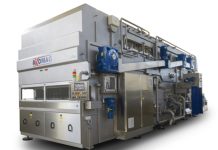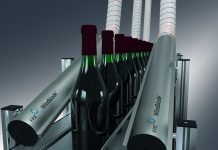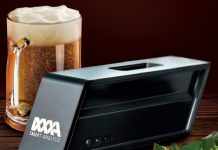Rolling hills formed by receding glaciers gently slope down to the shores of Lake Iseo and the terraced vineyards clinging to the hillsides are mirrored in the waters of the lake. We are in the Italian province of Brescia, in the territory of Franciacorta, a world-famous winemaking area with a name that stands not only for high quality sparkling wines but also for excellent reds and whites. Ca’ del Bosco has been one of the key players in making this name famous, with a company founded in the ‘60s by Annamaria Clementi Zanella, a woman who fell in love with and bought a small house in Franciacorta on a hill surrounded by a dense forest of chestnut trees. It wasn’t until a few years later, precisely in 1967, when Annamaria’s son Maurizio Zanella realized that the terrain was suited for growing grapes and planted the first vineyards. The years that followed were dedicated to studying the land and the territory, in search of an innovative way of making wine, from the optimal layout of the vineyard to the vinification techniques that near perfection. After having studied the methodology of the most famous wine in the world in the Champagne region, Maurizio Zanella introduced the first Bianco di Franciacorta with the help of French chef de cave André Dubois. As early as 1976 they started producing three sparkling wines, Brut, Dosage Zéro and Rosé, that were disgorged in 1978 and 1979.
Passion and innovation
This was how the exciting venture began, the quest for reaching a level of quality that would turn wine into a masterpiece. Stefano Capelli has been Ca’ de Bosco’s oenologist since 1985 and he brought along with him a wave of innovation and new technology. The cantina was expanded from 10,000 to 20,000 square meters, not to double the production capacity but to improve the technology of the systems employed. “Technology designed for grapes, with the aim of reducing the handling and processing to a minimum,” explains Stefano Capelli. “The objective is to enhance the characteristics of an excellent raw material, limiting as much as possible any contact with external agents. This is all part of the Ca’ del Bosco Method. It is our personal touch and maybe a little crazy, but we believe it’s unique. It means having the quality of the wine always in mind, as well as the integrity of the terrior and respect for tradition. For us the word “tradition” means continuous improvement, not resting on your laurels and basking in the glory of success. In Ca’del Bosco, we bring modernity together with the past”.

Certified organic viticulture . . . and much more
Even in the wine-making field there is much discussion about how to effectively produce an organic wine. Ca’ del Bosco chose to take on this challenge with an approach aimed at both the vineyard and the production process. Particularly in Franciacorta, the process starts with harvesting the Chardonnay grapes by hand and placing them in small crates of 15-17 kg each so that the clusters are not damaged. Then the Pinot Nero and Pinot Bianco grapes are harvested. Once in the cantina, the grapes are stored in cold rooms while waiting for the sorting and crushing by presses that were custom designed for Ca’ del Bosco. During the crushing of the clusters, the free run is divided into three qualities. The first is destined for the premium cuvee, the second is only partially utilized and the third is scrapped. Then it drops down into the fermentation vats by gravitational force, without the use of pumps that put stress on musts and wines. In addition, grapes coming from different vineyards are vinified separately according to their different terroirs and only during the fining step are the wines blended. This allows for each vintage to develop its best expression. Even the choice of yeasts is specific, with neutral yeasts so as not to damage the unique characteristics of the grapes. Regarding the use of barriques, there are set rules – wood is necessary to enhance the aromas of every wine but must never become a dominant element. “Ca’ del Bosco is truly dedicated to preserving the production potential of its vineyards and the sustainability of its own terroir” confirms Stefano Capelli. “In recent years we have made strategic choices that will soon result in managing all of our 181 hectares of vines according to certified organic viticulture methods. We started the conversion to organic winemaking in 2011 and today we have reached that goal with 100 hectares of terrain. The rest is to be converted over the next three years. Organic wine is most certainly a plus, although we are convinced that organic production is not automatically synonymous with quality or excellence. We sense the risk of a stand-off between modernists and traditionalists, an ideological dispute that will end up in justifying defective or disappointing wines only because they have “organic” on their label. In the winemaking world, there are no short-cuts or magic formulas. The naturalness of a product does not mean giving up clarifying or exclusively espousing indigenous yeasts. Our company tests solutions every year in our quest to continuously improve the product and in our search for absolute genuinity and purity of the wine. This continuing research has allowed us, for example, to drastically reduce the use of sulfites. Our Franciacorta today has a sulfite content of less than 50 mgs per liter, a level that is far lower than the UE limit of 185 mgs per liter for classic sparkling wines and 155 mgs per liter for organic classic sparkling wines. Starting in the fall of 2012, our challenge has been to put the exact concentration of sulfite content on the labels of our vintage wines.” One of the aspects of organic production also regards protecting the environment, limiting the use of pesticides and using natural systems to minimize or eliminate pollutants emitted into the air and soil. This is another area that Ca’del Bosco considers when making environment-related decisions. “To protect against parasites in the vineyards we have introduced innovative pesticide spraying systems that calibrate the application based on leaf wall density and systems that totally recover any excess product that was distributed. Also we have set up some natural barriers of Carpinus betula hedges to contain the risk that the phytosanitary treatments in the vineyards spill over to the nearby cycling paths and areas used by the local population. The water used to wash the pesticide application machines is treated with phytodepuration systems. To irrigate the company lawns, we have created some artificial ponds to catch the rainwater from the roofs and the cantina parking area and also the water recovered from the cleaning the cantina”.

The ”Grape Spa”
A few years ago an innovative washing system was introduced that employs a technique that has been dubbed as “The Grape Spa”. This technique, in addition to the already rigorous Ca’ del Bosco Method, has led to marked advantages in the quality of the final product. “The Grape Spa has been, without a doubt, the most significant innovation in the Ca’ del Bosco Method,” explains Capelli. “Since 2008 our vintage wines have been purer and since 2012 so has the rest of the production. We realized that a great deal of the problems in the first steps of vinification arise from the ambient impurities that are on the harvested grapes. Like all fruit, on the individual grapes, and therefore in the wine, many substances, some harmful and some innocuous, are present and these substances are of natural origin as well as non-natural. First of all there are micotoxins, produced by the molds and fungal parasites that build up microflora on the harvested grapes. Paradoxically, organically grown grapes are more at risk. Pollutants that are in the environment are present, even in infinitesimal levels, on the grape skins. Obviously there are pesticide residues as well. On the grape, in the must, in the grape pomace, and ultimately in the wine. This concentration of undesirable elements, at whatever level, can be reduced by as much as 80% with our grape washing system. After hand-harvesting and storage in the cold rooms, the crates are delicately emptied and the grapes are sorted by hand to eliminate anything that cannot be used in the must. At this point, the grape washing starts. There are a series of three soaking tanks where the grape clusters float about on the bubbling water for five minutes and then are dried so that the must does not become diluted. It’s like a giant grape jacuzzi and it removes all of the undesired toxic substances. Ca’ del Bosco made a significant investment in this complex system because we believe in the healthiness and purity of our wine. The qualitative advantages are numerous and quite evident if we take into consideration how it facilitates the fermentation metabolism of the yeasts – there are no “reduced” aromas, no inhibited flavors. We can confidently state that since 2012, our wines have become increasingly purer, easier to digest, better. And yes, more natural”.
Corking and bottling innovation
In the world of sparkling wines, the most persistent risk is the oxidation of the wine both during vinification as well as storage and especially during the disgorging step. Ca’ del Bosco has faced this difficulty head on and found, thanks to Stefano Capelli’s ideas, solutions for both the corking as well as bottling processes. “It is a known fact that classic method sparkling wines do not age after disgorging” explains Capelli. “A few months after being bottled and put on the market, they lose their potential. This mainly depends on the oxygen levels during vinification and storage, but particularly during the disgorging process. This is when the wine undergoes a brutal oxidation shock due to the oxygen that enters the bottleneck and remains there even after corking. Because of this undesired oxygen, which interrupts years of quiet resting on the lees, the wine undergoes a great deal of stress and starts down a regression process. The most common solution in these cases is to add a dose of sulfur dioxide and antioxidants. We have chosen to do otherwise. We are the only ones in the world to utilize a special corking machine that we designed ourselves. I patented it in November 2001, along with designer Piero Bielli of Arol. This technology allows us to eliminate the oxygen before corking. By disgorging without the presence of oxygen, we can further reduce the presence of sulfites, one of the goals that I have already mentioned. Our Franciacortas are healthier, tastier and have a longer life. We have also focused on the bottling step, which many do not consider so important. However, here the critical element is the filling machine. Ours is in the lower level of the cantina, below the tanks with the wine to be bottled. The wine flows by gravitational force down to the filler. It flows into the bottle through a special long tube which fills the bottle from the bottom up and eliminates the splashing and oxidative shock, and therefore reduces the quantity of oxygen that comes in contact with the wine.” All the phases of production and bottling are delicate in the winemaking process, whether producing sparkling and still whites or powerful reds. Therefore, constant and precise quality control is indispensable along the line.
Quality control throughout the entire process
In the Ca’ del Bosco cantina, the processes are monitored even before the bottling phase, starting with a residual water neutrality test after rinsing off the surfaces of the filler and corking machine. Then the detergent dosing nozzle in the bottle washer is inspected for proper operation followed by checking the standard of ozone monitoring sensor. When the line begins to operate, the neutrality of the residual water inside the bottles is tested as the bottles exit the washing station. During the bottling process, there are controls along the line to monitor the pick-up of oxygen starting at the bottling machine, entering/exiting the filters, entering the filler, after filling and lastly, after corking (Total Oxygen in Bottle). For still wines, the depth of the insertion of the cork and the internal pressure in the headspace is checked. For the Franciacorta wines, the process starts with monitoring the level of insertion of the bidule, then the visual control of the correct positioning of the crown cap over the cork and finally the calibrated testing of the security of the crown cap. In the lab, there are microbiological tests on the wine in the tanks, after filtering, at the entrance to the filler, after the filler and after corking. Stefano Capelli sums up, “In Ca’ del Bosco we believe in producing a healthy and high quality wine. A nobel wine. We believe that wine is not a brand or a name. We believe that Ca’ del Bosco today is the company we envisioned from the beginning, a pioneer, a little crazy and a true to our ideas”.
Technical specifications of the bottling line
- Empty bottle depalletizer: ACMI
- Bottlewasher: Bardi
- Computer-controlled Bottle Filler: KHS
- Tri-block corker (crown/bidule/cork): AROL
- Corks sorter/orientor for natural corks: Mar.Co.
- System Conveyor : ACMI
- CIP System: Adue
- Packaging Robot: ABB EVOLUT
- Hourly production capacity: 4,500 bottles
- Daily production capacity: approximately 35,000 bottles




